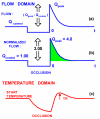Digital thermal monitoring (DTM) of vascular reactivity closely correlates with Doppler flow velocity
- PMID: 19964497
- PMCID: PMC3341617
- DOI: 10.1109/IEMBS.2009.5333962
Digital thermal monitoring (DTM) of vascular reactivity closely correlates with Doppler flow velocity
Abstract
The noninvasive measurement of peripheral vascular reactivity, as an indicator of vascular function, provides a valuable tool for cardiovascular screening of at-risk populations. Practical and economical considerations demand that such a test be low-cost and simple to use. To this end, it is advantageous to substitute digital thermal monitoring (DTM) for the more costly and complex Doppler system commonly used for this measurement. A signal processing model was developed to establish the basis for the relationship between finger temperature reactivity and blood flow reactivity following a transient brachial artery occlusion and reperfusion protocol (reactive hyperemia). Flow velocity signals were acquired from the radial artery of human subjects via an 8 MHz Doppler probe while simultaneous DTM signals were acquired from a distal fingertip via DTM sensors. The model transforms the DTM temperature signals into normalized flow signals via a deconvolution method which employs an exponential impulse function. The DTM normalized flow signals were compared to simultaneous, low-frequency, normalized flow signals computed from Doppler sensors. The normalized flow signals, derived from DTM and Doppler sensors, were found to yield similar reactivity responses during reperfusion. The reactivity areas derived from DTM and Doppler sensors, indicative of hyperemic volumes, were found to be within +/- 15%. In conclusion, this signal processing model provides a means to measure vascular reactivity using DTM sensors, that is equivalent to that obtained by more complex Doppler systems.
Figures




Similar articles
-
Reproducibility and variability of digital thermal monitoring of vascular reactivity.Clin Physiol Funct Imaging. 2011 Nov;31(6):422-8. doi: 10.1111/j.1475-097X.2011.01037.x. Epub 2011 Jul 3. Clin Physiol Funct Imaging. 2011. PMID: 21981452
-
Low fingertip temperature rebound measured by digital thermal monitoring strongly correlates with the presence and extent of coronary artery disease diagnosed by 64-slice multi-detector computed tomography.Int J Cardiovasc Imaging. 2009 Oct;25(7):725-38. doi: 10.1007/s10554-009-9476-8. Epub 2009 Jul 26. Int J Cardiovasc Imaging. 2009. PMID: 19634001 Free PMC article.
-
Sensitivity of digital thermal monitoring parameters to reactive hyperemia.J Biomech Eng. 2010 May;132(5):051005. doi: 10.1115/1.4001137. J Biomech Eng. 2010. PMID: 20459206
-
Assessment of endothelial and neurovascular function in human skin microcirculation.Trends Pharmacol Sci. 2013 Jul;34(7):373-84. doi: 10.1016/j.tips.2013.05.007. Epub 2013 Jun 21. Trends Pharmacol Sci. 2013. PMID: 23791036 Review.
-
Estimation of blood perfusion using ultrasound.Proc Inst Mech Eng H. 1999;213(2):91-106. doi: 10.1243/0954411991534834. Proc Inst Mech Eng H. 1999. PMID: 10333683 Review.
Cited by
-
Non-invasive digital thermal monitoring and flow-mediated dilation in systemic sclerosis.Clin Exp Rheumatol. 2019 Jul-Aug;37 Suppl 119(4):97-101. Epub 2019 Sep 17. Clin Exp Rheumatol. 2019. PMID: 31573479 Free PMC article.
-
Infrared imaging of nitric oxide-mediated blood flow in human sickle cell disease.Microvasc Res. 2012 Nov;84(3):262-9. doi: 10.1016/j.mvr.2012.06.011. Epub 2012 Jul 8. Microvasc Res. 2012. PMID: 22784510 Free PMC article.
-
High Frequency of Microvascular Dysfunction in US Outpatient Clinics: A Sign of High Residual Risk? Data from 7,105 Patients.Int J Vasc Med. 2022 Jan 6;2022:4224975. doi: 10.1155/2022/4224975. eCollection 2022. Int J Vasc Med. 2022. PMID: 35036009 Free PMC article.
-
New Indices of Endothelial Function Measured by Digital Thermal Monitoring of Vascular Reactivity: Data from 6084 Patients Registry.Int J Vasc Med. 2016;2016:1348028. doi: 10.1155/2016/1348028. Epub 2016 Oct 18. Int J Vasc Med. 2016. PMID: 27830091 Free PMC article.
References
-
- Naghavi M. Preventive Cardiology: The SHAPE of the future. A Synopsis from the Screening for Heart Attack Prevention and Education (SHAPE) Task Force report. Herz. 2007 Aug;32(5):356–61. - PubMed
-
- Ley O, Deshpande C, Prapamcham B, Naghavi M. Lumped parameter thermal model for the study of vascular reactivity in the fingertip. J Biomech Eng. 2008 Jun;130(3):031012. - PubMed
-
- Ahmadi N, Tirunagaram S, Hajsadeghi F, Flores F, Saeed A, Hecht H, Naghavi M, Budoff M. Concomitant insulin resistance and impaired vascular function is associated with increased coronary artery calcification. Journal of Cardiology. 2009 Feb 4; IJCA-11676. - PubMed
-
- Li JK-J. Dynamics of the Vascular System, Series on Bioengineering & Biomedical Engineering - Vol. 1. World Scientific; 2004. pp. 206–207.
MeSH terms
Grants and funding
LinkOut - more resources
Full Text Sources
Medical
